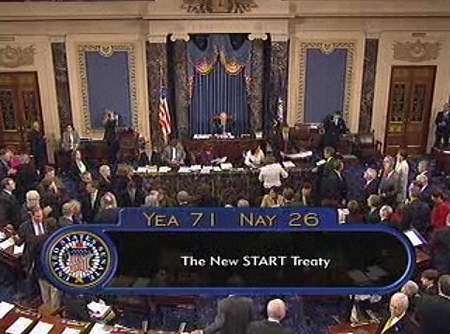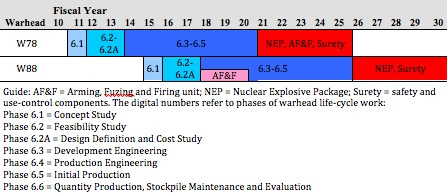British Submarines to Receive Upgraded US Nuclear Warhead
Sea-launched ballistic missiles on British ballistic missile submarines will be armed with the upgraded W76-1 nuclear warhead currently in production in the United States, according to a report from Sandia National Laboratories.
According to the Labs Accomplishments from March 2011, “the first W76-1 United Kingdom trials test was performed at WETL [Weapon Evaluation Test Laboratory], providing qualification data critical to the UK implementation of the W76-1.”

The Royal Navy plans to “integrate” the US W76-1/Mk4A warhead onto British SSBNs.
Rumors have long existed that the nuclear warhead currently used on British sea-launched ballistic missiles (SLBMs) is very similar to the U.S. W76 warhead deployed on American SLBMs. Official sources normally don’t give U.S. warhead designations for the British warhead but use another name. A declassified document published by the National Nuclear Security Administration (NNSA) in 1999, which I published in 2008, described maintenance work on the W76 warhead but called the British version the “UK Trident System.”
 |
| Labs Accomplishments from Sandia National Laboratories describes “the first W76-1 United Kingdom trial test” and “UK implementation of the W76-1.” Download the publication here. |
The Sandia report, on the contrary, explicitly uses the U.S. warhead designation for the warhead on British SLBMs: W76-1.
Approximately 1,200 W76-1s are current in production at the Pantex Plant in Texas. The W76-1 is an upgraded version of the W76-0 (or simply W76) produced between 1978 and 1987. In its full configuration, the upgraded weapon is known as the W76-1/Mk4A, where the Mk4A is the designation for the cone-shaped reentry body that contains the W76-1 warhead.
After first denying it, the British government has since confirmed that the Mk4A reentry body is being integrated onto the British SLBMs but it has been unclear which warhead it will carry: the existing warhead or the new W76-1. The Sandia report appears to show that the United Kingdom will get the full package: W76-1/Mk4A.
HMS Vanguard launches US-supplied Trident II D5 SLBM off Florida in October 2005. In the future, missiles on British submarines will carry US-supplied W76-1/Mk4A nuclear warheads.
The upgrade extends the service life by another 30 years to arm U.S. and British nuclear-powered ballistic missile submarines (SSBNs) through the 2040s. That timeline fits the 2010 British Strategic Defence Review finding that “a replacement warhead is not required until at least the 2030s.”
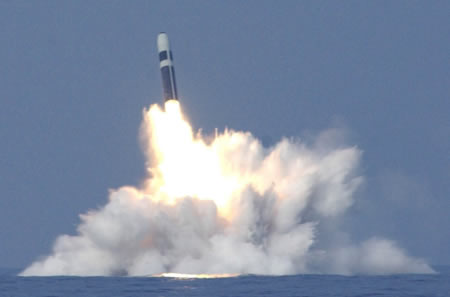 |
| HMS Vanguard launches US-supplied Trident II D5 SLBM off Florida in October 2005. In the future, missiles on British submarines will carry US-supplied W76-1/Mk4A nuclear warheads. |
.
The transfer of W76-1/Mk4A warheads to the United Kingdom further erodes British claims about having an “independent” deterrent. The missiles on the SSBNs are leased from the U.S. Navy, the missile compartment on the next-generation SSBN will be supplied by the United States, and new reactor cores that last the life of future submarines hint of substantial U.S. nuclear assistance.
The transfer of nuclear technology from the United States to Britain is authorized by the 1958 US-UK Mutual Defense Agreement, which was most recently updated in 2004 and extended through 2014 to permit the “transfer of nonnuclear parts, source, byproduct, special nuclear materials, and other material and technology for nuclear weapons and military reactors” between the two countries. The will text is secret but a reconstructed version is here (see note 3).
Acknowledgements: Thanks to Nick Ritchie at Bradford University (“US-UK Special Relationship”) and John Ainslie at Scottish CND.
This publication was made possible by a grant from Carnegie Corporation of New York and Ploughshares Fund. The statements made and views expressed are solely the responsibility of the author.
New START Data Exchange: Will it Increase or Decrease International Nuclear Transparency?
 |
| U.S. officials say that aggregate numbers of the New START treaty will be made publicly available but that these may be very general numbers and a decision still has to be made. For a copy of the final START aggregate numbers, click here. |
.
By Hans M. Kristensen
The first data exchange of the New START treaty between the United States and Russia has taken place, according to a report by RIA Novosti.
This is the first of more than 20 such data exchanges planned under the treaty for the next 10 years where Russia and the United States twice a year will send each other a list showing how many long-range ballistic missiles and heavy bombers they have and how many nuclear weapons they carry.
But while the exchanges will increase U.S-Russia nuclear transparency, the rest of the world may be facing a future with less information about U.S. and Russian strategic nuclear forces than in the past.
“All exchanges are classified and will not be subject to release,” a U.S. official told me. “There may be some information on very general numbers under the Treaty that could be made public, but that is still to be determined, and will not occur for a least six months if it occurs at all.”
Previous Nuclear Transparency
During the previous START treaty regime between 1994 and 2009, the two countries also exchanged data. That data was classified but the two sides released so-called aggregate numbers biannually to the public (the final START release is here]. Rose Gottemoeller, the U.S. Assistant Secretary for the Bureau of Arms Control, Verification and Compliance, assured early on that “data on the aggregate number of warheads each Party deploys on ICBMs and SLBMs will be exchanged and made publicly available” for New START as well. (Emphasis added)
Hopefully that will happen, but the aggregate numbers release was based on a much larger document – the Memorandum of Understanding (MOU) – exchanged between the two countries twice a year. The unclassified MOU was not published because (I was told) of Russian objections, but the United States would – upon request – release the MOU, which provided much more detailed data for each nuclear weapon and facility.
| START July 2009 Memorandum of Understanding |
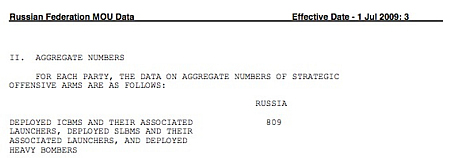 |
| The first START treaty provided the public with detailed overviews of U.S. and Russian strategic nuclear forces. Will New START do so as well or decrease international nuclear transparency? To down copy of the final START MOU, click here. |
.
The MOU provided important information for the international community to monitor the development of U.S. and Russian long-range nuclear forces. But the official statements made so far suggest that such detailed information might not be released under New START.
Implications and Recommendations
The New START treaty is widely seen as a first step in a process that seeks to involve other nuclear weapon states in future nuclear arms control negotiations. As such, it is important that the United States and Russia continue to make detailed information on the status of their nuclear forces available to the international community.
At the very least, this should include the aggregate numbers – including breakdown by individual nuclear weapon systems. But it should also continue the practice of releasing the full unclassified MOUs to increase international transparency and predictability in nuclear forces. Doing anything else would be a step back that could create mistrust and undercut a broadening of the nuclear arms control progress to other nuclear weapon states.
Each new step in the arms control process must increase transparency, not reduce it.
This publication was made possible by a grant from Carnegie Corporation of New York and Ploughshares Fund. The statements made and views expressed are solely the responsibility of the author.
Nuclear Hiccup in South Korea: The Limits of Tactical Nukes
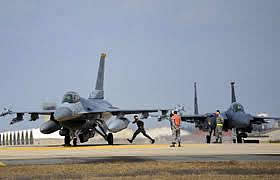 |
| The F-16s (left) of the 8th Fighter Wing at Kunsan Air Base in South Korea lost their nuclear capability in 1991. The F-15Es (right) of the 4th Fighter Wing at Seymour Johnson Air Base in North Carolina no longer are certified for the nuclear strike mission. Instead, extended deterrence is served by conventional forces and long-range nuclear bombers and ballistic missiles. |
By Hans M. Kristensen
In a surprising report, Korea Joongang Daily reported yesterday that White House coordinator for arms control and weapons of mass destruction, Gary Samore, had said that the United States would redeploy nuclear weapons to South Korea if the South Korean government asked for it.
I don’t know what Samore said or meant to say, but the hiccup comes at particularly bad time after two North Korean nuclear tests, its suspected sinking of a South Korean warship and the shelling of Yeonpyeong island, and repeated large-scale U.S.-South Korean military exercises, all of which have raised tension on the troubled Korean Peninsula again.
Fortunately the White House quickly corrected the record, explaning that “tactical nuclear weapons are unnecessary for the defense of South Korea and we have no plan or intention to return them” to the country.
It is particularly important that the rebuttal included more than “we have no plan” but also reiterated the fact that tactical nuclear weapons are “unnecessary” for the defense of South Korea.
As a consequence, the U.S. Air Force has over the past several years phased out the nuclear mission of two fighter wings in the United States that previously were tasked to forward deploy to Europe or Asia with tactical nuclear weapons (an example of a nuclear exercise in 1998 is available here). The F-15E aircraft of one of the wings, the 4th Fighter Wing at Seymour Johnson Air Base in North Carolina, are still considered nuclear capable but are no longer nuclear certified. Instead, the extended deterrence mission in Asia is, as it should be, served by forward-deployed conventional and long-range nuclear forces.
That tactical nuclear weapons are not necessary to defend a key ally is a fact that NATO should learn from. Nearly 200 U.S. tactical bombs are stuck in Europe because the alliance can’t figure out how to do what South Korea did 20 years ago. All the more strange because NATO, unlike South Korea, doesn’t have a large military threat right next door.
Background: A History of US Nuclear Weapons in South Korea
This publication was made possible by a grant from Carnegie Corporation of New York and Ploughshares Fund. The statements made and views expressed are solely the responsibility of the author.
Talk at Georgetown U Event on Tac Nuke Treaty
By Hans M. Kristensen
The Center on National Security and the Law and the Federal Legislation and Administrative Clinic co-hosted an event at Georgetown University Law Center on Tuesday, March 1st: Next Steps after New START: A Treaty on Tactical Nuclear Weapons.
The event included a keynote speech by Edward Warner, the Senior Advisor to the under Secretary of Defense for Policy.
I gave a briefing on the status of US and Russian nonstrategic nuclear weapons. Other panelists included Michael May, former director of Lawrence Livermore National Laboratory and now at Stanford University, Paul Dean from the Department of State, Madelyn Creedon with the Senate Armed Services Committee, and Tim Morrison from the office of Senator Jon Kyl. Dakota Rudesill from the Law Center moderated.
This publication was made possible by a grant from Carnegie Corporation of New York and Ploughshares Fund. The statements made and views expressed are solely the responsibility of the author.
Documents Obtained by FAS Shed New Light on US Arms Transfers
by Matt Schroeder
The Federation of American Scientists has acquired two previously unreleased US government reports on arms transfers, one on recent sales of US weapons and the other on arms purchased for the Afghanistan government with US military aid. Both documents were acquired under the Freedom of Information Act.
The first report, which is often referred to as the Section 36(a) report after the section in the Arms Export Control Act that requires it, contains data on, inter alia, Foreign Military Sales, transfers of Excess Defense Articles, grants and loans through the Foreign Military Financing Program, projected arms sales, Foreign Military Construction Sales, and Security Assistance Surveys (including end-use monitoring). The report contains detailed data on transfers of Major Defense Equipment in 2009 and the total value of arms transfers by country in the first quarter of Fiscal Year 2010 (1 October – 31 December 2009). Given recent unrest in the Middle East, data on recent or pending arms sales to Bahrain, Egypt, and Yemen is likely to be of particular interest.
The other document acquired by the FAS is a lengthy (137 page) list of arms procured through the Defense Department’s Afghanistan Security Forces Fund (ASFF). The millions of items listed in the report range from “drugs and surgical dressings” to M24 sniper rifles to Russian cargo aircraft. Given that many of these purchases are not recorded in the main annual reports on US arms sales, this document may be the most complete (consolidated) source of data on items acquired through the ASFF.
Air Force Magazine Prints Nuke Chart
 |
By Hans M. Kristensen
The January 2011 issue of Air Force Magazine has a nice spread on the Chart Page where they reproduce a chart I produced of U.S. and Russian nuclear warhead inventories.
The chart is the product of the research and public education I do about the status of nuclear forces in collaboration with the nuclear program over at the Natural Resources Defense Council.
This chart was initially used in a de-alerting briefing at the United Nations last October.
This publication was made possible by a grant from Carnegie Corporation of New York and Ploughshares Fund. The statements made and views expressed are solely the responsibility of the author.
GAO Report Challenges Nuclear Weapons Spending Spree
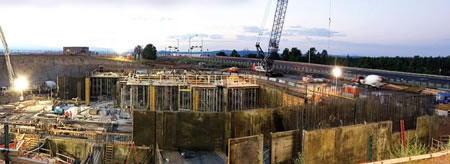 |
| The General Accounting Office concludes that NNSA lacks the basis for justifying multi-billion dollar modernization projects such as the Chemical and Metallurgy Research Replacement Facility at Los Alamos National Laboratory in Los Alamos, New Mexico. |
.
By Hans M. Kristensen
At a time when the National Nuclear Security Administration (NNSA) is asking Congress to authorize billions of dollars to modernize what it calls its “aging” nuclear infrastructure for maintaining and producing nuclear weapons, a new report from the General Accounting Office (GAO) concludes that “NNSA does not have accurate, reliable, or complete data on the condition and replacement value of its almost 3,000 weapons activities facilities.”
The new budget request to be released today is expected to request billions of dollars to modernize the nuclear weapons complex.
In a blunt statement that appears to challenge the administration’s request for more money to build new nuclear weapons factories, the GAO report points out that “NNSA has not estimated total costs for the largest projects it is conducting—the Chemical and Metallurgy Research Replacement Facility at Los Alamos National Laboratory in Los Alamos, New Mexico, and the Uranium Processing Facility at the Y-12 Plant in Oak Ridge, Tennessee. DOE regulations do not require a total cost estimate until the initial design phase is complete, but without reliable cost and schedule data NNSA does not have a sound basis to justify decisions and planned budget increases.”
[Addition: The GAO report unfortunately makes the same mistake that the news media makes all the time when describing the New START treaty. According to the report, “As part of this plan and arms control treaties, the United States has agreed to reduce the size of its strategic nuclear weapon stockpile from a maximum of 2,200 to 1,550 weapons.” But the United States has not agreed to reduce its strategic nuclear weapon “stockpile” to 1,550 weapons. The limit it has agreed to is to deploy no more than 1,550 strategic warheads on operational launchers (essentially all ballistic missiles because bomber weapons are not counted even if they were loaded on the aircraft). Several thousand reserve but fully intact strategic warheads as well as nonstrategic warheads are not limited by New START. The new treaty is important for many reason, but the difference is actually important. The U.S. nuclear weapons stockpile currently contains approximately 5,000 nuclear warheads.]
See also this blog about the Obama administration nuclear weapons stockpile stewardship management plan.
This publication was made possible by a grant from Carnegie Corporation of New York and Ploughshares Fund. The statements made and views expressed are solely the responsibility of the author.
New START: It’s in the Bag!
 |
| The New START treaty is in the bag, approved by the US Congress and Russian Duma. |
.
By Hans M. Kristensen
The upper house of the Russian Parliament (Duma) earlier today approved the New START treaty signed by presidents Medvedev and Obama in Prague on April 8, 2010. This follows approval of the treaty by the U.S. Senate in December despite opposition from hard-liners.
The Russian approval was followed by optimistic statements by Mikhail Margelov, the chairman of the international affairs committee, who declared: “The arms race is a thing of the past. The disarmament race is taking its place.”
What Now?
Now that the treaty has been ratified by both countries, the next step will be an exchange of Instruments of Ratification, at which point the treaty formally enters into effect. When that happens, the Moscow Treaty from 2002 will expire. Within 45 days after entry into force, the two countries will have an initial exchange of data (an initial exchange of site diagrams occurred 45 days after the treaty was signed on April 8, 2010), and photographs of the strategic offensive arms covered by the treaty will be exchanged. After that the inspectors go to work.
No it Doesn’t
But the treaty does not, as the New York Times report mistakenly states, “require the United States and Russia to reduce their nuclear arsenals…to 1,550 warheads each, from between 1,700 and 2,200 now.” This is a misreporting that is frequent in the news media (see also RIA Novosti). In fact, the treaty does not place any limits on the total size of their nuclear arsenals — in fact, it doesn’t require destruction of a single nuclear warhead. Rather, New START reduces the limit for how many of their strategic warheads the two countries may deploy on long-range delivery vehicles at any given time. Both countries may – and do – have thousands of other nuclear warheads that are not deployed or not counted.
Of the estimated 5,000 and 8,000 US and Russian, respectively, nuclear warheads in their military stockpiles, New START affects how 1,550 can be deployed on each side. How to deal with the remaining thousands of non-deployed and nonstrategic nuclear warheads is the focus of the next round of US-Russian nuclear arms control efforts. In addition, both countries have thousands of additional retired but intact warheads awaiting dismantlement, for total estimated inventories of 8,500 US and 11,000 Russian warheads.
New START is in the bag but a lot of work remains to be done.
This publication was made possible by a grant from Carnegie Corporation of New York and Ploughshares Fund. The statements made and views expressed are solely the responsibility of the author.
Senate Approval of New START Moves Nuclear Arms Control Forward
By Hans M. Kristensen
The Federation of American Scientists today applauded the Senate’s ratification of the New START (Strategic Arms Reduction Treaty) between the United States and Russia.
The Senate voted 71 to 26 in favor of ratification of the treaty.
The approval of the treaty is a victory for common sense and an impressive achievement for the Obama administration in overcoming stubborn opposition from Cold Warriors to modest nuclear arms reductions.
New START does not require destruction of a single nuclear warhead, but it reduces the limit for how many of them can be deployed on long-range ballistic missiles and heavy bombers.
The United States and Russia possess more than 90 percent of the world’s nuclear weapons and will continue to do so when the treaty limit is reached seven years from now.
During the past year and in an effort to ensure Congressional support for New START, the administration has committed to significant increases in spending on modernizing nuclear weapons and the production complex over the next decade: well over $100 billion for modernization of missiles and bombers, and more than $85 billion for modernizing warheads and production facilities.
This modernization will have to be balanced against the other important goal of U.S. nuclear policy: securing international support for strengthening non-proliferation of nuclear weapons and materials. Demonstrating clear intensions to reducing the number and role of nuclear weapons will be essential to winning support for this agenda.
Despite its limitations, the approval of the New START treaty brings U.S-Russian strategic relations back on track, reestablishes a vital on-site inspection regime, and potentially opens the way for negotiations on additional reductions in the future.
Those negotiations must establish limits on and verification of U.S. and Russian non-deployed and non-strategic nuclear weapons, and prepare the ground for broadening nuclear arms control to the other nuclear weapons states.
This publication was made possible by a grant from Carnegie Corporation of New York and Ploughshares Fund. The statements made and views expressed are solely the responsibility of the author.
Tac Nuke Numbers Confirmed?
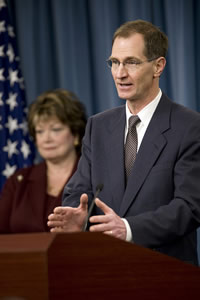 |
| PDUSPD Jim Miller appears to confirm FAS/NRDC estimates for NATO and Russia tactical nuclear weapons. |
By Hans M. Kristensen
A Wikileaks document briefly posted by The Guardian Monday appears to give an official number for the U.S. nuclear weapons deployed in Europe: 180.
The number appears in a leaked cable written by U.S. NATO Ambassador Ivo Dalder in September 2009, describing an earlier Nuclear Posture Review briefing U.S. Principal Deputy Under Secretary of Defense for Policy Jim Miller gave to NATO in July 2009.
Miller’s number is smack in the middle of the estimate Stan Norris and I have developed. I recently published a snapshot here (previous NATO posts are here), and a more detailed overview will appear in the January Nuclear Notebook in the Bulletin of the Atomic Scientists.
Miller also stated that Russia had 3,000-5,000 plus tactical nuclear weapons. That also fits our estimate of approximately 5,300 weapons, previously published here and here.
Whether Miller was providing certified U.S. intelligence numbers or simply referenced good-enough nonofficial public estimates is less clear. But his use of a specific number (180) for Europe rather than a range suggests that it might an official number.
It’s Up, It’s Down
The cable first appeared in a Guardian story that was posted on the news paper’s web site Monday with the cable. The posting was a mistake and the story was quickly taken down (the editors decided that the initial story didn’t contain significant news; it may get back up), but not before bloggers had picked it up. The first reposting of the document appeared on Hedgehogs.
I’ve since tried to find the cable on the Wikileaks web site, but it doesn’t seem to be there. If anyone knows the original link, please let me know.
Implications
I’ll publish on U.S. and Russian tactical nuclear weapons later in 2011, but the importance of the number 180 (if correct) is that it confirms that the United States during the past decade has been unilaterally reducing the deployment in Europe without demanding reductions in Russian tactical nuclear weapons. Miller correctly points to “the difficulty of bringing Russia to the bargaining table with 180 NATO sub-strategic warheads on offer against the estimated 3-5 thousand Russian warheads in that category.”
As I recently pointed out, there is important progress in NATO’s new Strategic Concept, but some language is unfortunate because it appears to reinstitute Russian as an adversary by demanding that any addition reductions in U.S. nuclear weapons in Europe must take into consideration Russia’s larger inventory of tactical nuclear weapons.
Some Baltic NATO countries have called for new contingency planning against Russia, but Ambassador Dalder pointed to the dilemma this creates for NATO’s long-held position that Russia is not an enemy.
I couldn’t agree more. NATO and the United States should certainly try to convince Russia to reduce its tactical nuclear weapons, but the previous unilateral U.S. reductions in Europe demonstrate that NATO can and should decide the future of the remaining U.S. nuclear weapons in Europe independent of the number of Russian tactical nuclear weapons.
This publication was made possible by a grant from Carnegie Corporation of New York and Ploughshares Fund. The statements made and views expressed are solely the responsibility of the author.
Congress Receives Nuclear Warhead Plan
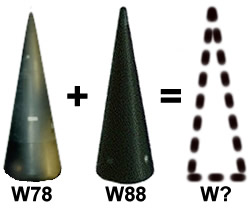 |
| A white paper describes plans for a joint warhead. |
By Hans M. Kristensen
The National Nuclear Security Administration (NNSA) has sent Congress a white paper describing plans for extending the life of the W78 warhead on the Minuteman III intercontinental ballistic missile (ICBM).
According to the paper, W78 Life Extension Program Description and Work Scope, a Phase 6.1 study would begin in February 2011 and seek to produce the first warhead in 2021.
Although focused on extending the life of the W78 warhead itself, the study includes an adaptable warhead option to join the W78 and W88 warheads for the purpose of producing a modified warhead that can be deployed on both the Minuteman and the Navy’s Trident II D5 sea-launched ballistic missile (SLBM).
A Joint Warhead
The NNSA white paper states that the Phase 6.1 study will explore the “W78 Military Characteristics (MCs) including military requirements for a system that could be fielded with both the Mk12A and Mk5 reentry systems.”
A joint warhead option raises important questions: How different will the new warhead be compared with the current W78 and W88 types? Will it be closer to the W78 or the W88 design? Will it be a “reliable replacement warhead”?
Part of the white paper language suggests that the joint warhead might be closer to the W78 than the W88. Indeed, the initial requirement for the W78 back in the 1970s was for both ICBM and SLBM deployment:
“The planned approach represents an important opportunity to extend W78 service life, incorporate modern safety, security, and control features and, if the W78 LEP is also able to address the requirements of the W88, gain substantial efficiencies and cost reduction. In fact, the original MCs of the W78 (published in 1974) defined a requirement, yet technologically unmet, for a nuclear warhead for both the Minuteman III and the Trident II delivery systems. This was not feasible then but, in all likelihood, is feasible today.” (Emphasis added)
The white paper promises that, “the W78 LEP will use only nuclear components based on previously tested designs, and will not support new military missions or provide for new military capabilities.”
But for a joint warhead option, a W78 LEP deployed on SLBMs will obviously have to meet similar military requirements as the W88. Both warheads are hard-target kill weapons, yet the yield of the W88 is more than 100 kt greater than the W78 (see table). So unless the military reduces its requirements for the SLBM mission, then the capability of the W78 LEP warhead obviously would have to be increased to meet both missions.
| W78 and W88 Warhead Profiles |
 |
| * Pits (plutonium cores) for W88 replacement warheads are currently being produced at the Los Alamos National Laboratory. |
.
The W78 and W88 designs currently have “single yield” so one possibility could be to add more yield options to a joint warhead to meet both missions. A new Arming, Fuzing and firing (AF&F) unit might also provide new targeting flexibility that improves the kill capability of the warhead (similarly to the Mk4A/W76-1 SLBM warhead currently being produced). Or a decision to increase the accuracy of the missiles could reduce the yield requirement.
Regardless of which design option is chosen, a joint warhead would appear to require some new military capabilities.
NNSA’s previous warhead refurbishment chart from FY2009 did not list a new AF&F for the W78 LEP, nor did it list new surety features for the W78 or W88 warhead. But the chart in the FY2011 Stockpile Stewardship Management Plan (SSMP) lists new AF&F and surety features for all future life-extension programs (see chart).
| Scheduled W78 and W88 Life Extension Programs |
|
|
| Following immediately after scheduled completion of the W76 and W61 life extension programs, the administration is planning life extension programs for the W78 and W88 warheads. A joint ICBM-SLBM warhead would combine the W78 and W88 programs. |
.
How Many Warheads?
If the joint warhead becomes a modified version of the W78, what will happen to the W88? The Nuclear Posture Review stated that the W78 LEP study would examine “the possibility of using the resulting warhead also on SLBMs to reduce the number of warhead types.” (Emphasis added) And a joint warhead, the NNSA white paper states, “could provide opportunities to reduce further reserve warheads.” (Emphasis added)
That language suggests an intention to replace the W88. If so, how many W78 LEP warheads would be needed for both missions?
Nearly 1,000 W78 warheads were produced between 1979 and 1982, but only 250 or so are currently deployed with an additional 350 in reserve for a total of about 600 W78s remaining in the stockpile. Over the years, a couple of hundred W78s have been consumed in destructive quality control experiments.
Approximately 400 W88s were produced between 1989 and 1991, of which roughly 380 are deployed. Warheads lost in destructive quality control experiments are currently being replaced by new production warheads at Los Alamos National Laboratory.
Assuming the number of deployed ICBMs and SLBMs will shrink to 420 and 240, respectively, over the next decade, the potential number of new joint warheads might be roughly 800 (in addition to the W87 and W76-1s deployed on the two platforms).
Stockpile Diversity and Reliability
A strategy to reduce warhead types is different from the RRW program of the Bush administration, which argued that replacement of warheads was important partly to preserve “diversity” of the stockpile. The thinking was that two warhead types per delivery platform would safeguard against a catastrophic technical warhead defect crippling a leg of the Triad.
Since a joint ICBM/SLBM warhead would reduce the warhead types for those platforms from four to three, a technical failure of the joint warhead would significantly affect the capability of both legs, instead of just one of them. That, ironically, could increase the vulnerability of the two legs and drive a requirement to maintain more W87 and W76-1 warheads in reserve than otherwise.
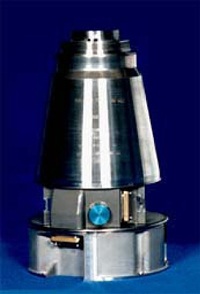 |
| The administration is rushing a W88 AF&F replacement in 2018-2919, well ahead of the full LEP schedule. |
The white paper states that “the W78 LEP will use only nuclear components based on previously tested designs,” a pledge also made by the NPR. But the addition of new components such as the AF&F and safety and security features can potentially create serious risks for predicting weapons reliability.
Some of the safety features being explored by the weapons labs include replacing chemical high explosives (CHE) with insensitive high explosives (IHE), and adding multi-point safety to the warheads.
Except for the W87, all U.S. ballistic missile warheads have conventional high explosives, potentially making them less safe than the W87. The newest missile warhead, the W88, was designed with the less safe explosive to reduce weight in order to increase the number of warheads that would be delivered by each missile. Using the W87 to replace the W88 would seem a better option (although the W87 yield is less than the W78), but there are too few W87s in the stockpile to load both ICBMs and SLBMs and the warhead is not scheduled for an LEP until the late-2030s. Another way to increase safety is to handle the warheads less and improve handling procedures. Deploying warheads on high alert, for example, significantly increases safety risks.
All warheads are currently single-point safe, which means if the high explosive is detonated at any single point, there will be less than one chance in a million that more yield will result than the equivalent to exploding four pounds of high explosives. Multi-point safety would ensure the same safety margin if multiple high explosives detonated simultaneously, but that would require significant changes to the warhead design and potentially decrease confidence in its reliability. Besides, no warhead accident has ever resulted in a nuclear yield.
In other words, the risks and uncertainties associated with producing a new joint warhead are many and it is far from clear that they would allow a reduction of the number of reserve warheads.
Cost Projections
The NNSA white paper does not include cost projections for the W78 LEP, but the FY2011 Stockpile Stewardship Management Plan does. Through 2025, the program is projected to cost more than $4 billion, or roughly $7 million per stockpiled W78 warhead.
| Projected W78 Life Extension Program Costs |
 |
| The administration projects the cost of the W78 life extension program will reach more than $4 billion through 2025. A joint ICBM-SLBM warhead would increase costs significantly. |
.
Combining the W78 and W88 would significantly increase this cost projection.
The administration’s budget includes $26 million to begin the Phase 6.1 study in February 2011, and STRATCOM apparently has already completed its assessment for a joint warhead but has not yet released its report.
But the Phase 6.1 study cannot begin until the Pentagon provides Congress with a clear need or military requirement for NNSA to pursue the joint warhead option. There are many questions that need to be answered.
This publication was made possible by a grant from Carnegie Corporation of New York and Ploughshares Fund. The statements made and views expressed are solely the responsibility of the author.
New START Ratification: Seeing the Bigger Picture
 |
| Morton Halperin speaks at CSIS |
By Hans M. Kristensen
Kevin Kallmyer at CSIS has an interesting recap of a recent debate between Paula DeSutter and Mort Halperin about the New START Treaty.
Ratification of the treaty is held up in Congress by a handful of Senators who (mis)use questions about, among other issues, verification to extort billions of dollars to pet nuclear modernization projects at the expense of greater U.S. interests.
During the CSIS debate, Mort Halperin provided an enlightening anecdote about how to judge whether ratification of the treaty is in the U.S. interest. It cuts to the heart of what is important and deserves a repost here:
How do you decide whether a Treaty is in the American interest in relation to verification? The question cannot be are we sure that we will have 100% confidence that we would detect the first instance of Russian cheating. The question has to take into account the limits of the Treaty, and some degree of Russian cheating, is it in our interest to have the limit in the treaty, as opposed to not constraining the Russian forces. Our notion of what is acceptable verification goes back to the Reagan administration, it actually goes back before that…because the last time the Joint Chiefs of Staff held the view that a limit was not acceptable unless it could be 100% verifiable was in 1968. At that point, the Administration was planning to put forward a proposal to the Soviet Union to ban the further production of any ballistic missiles or submarines. The Joint Chief’s position then was to we can only include things in the agreement if we could be absolutely certain there will be no Russian cheating. A navy officer came to me one day and said, “Well, we cannot include submarines in the agreement.”
I said, “Why is that?”
He said, “Because the CIA has just come out with its estimate that said the Russians could cheat on an agreement that bans Russia from building any more ballistic missile submarines.”
And I said, “What does it say?”
He said, “It says the Russians could build as many as 3 submarines and we wouldn’t detect it, and only if they build a fourth submarine could we have very high confidence of detection.”
And I said, “How many submarines doe we have now?”
He said, “41.”I said, “How many submarines do we plan to have 10 years from now.”
He said “41.”
I said, “How many submarines do the Russians have now?”
He said, “I think one.”
I said, “How many do we think they will have in 10 years from now.”
He said, “50.”
I said, “So, you prefer a world where we do not limit this and the Russians have 50 submarines and we have 41, to a world where we have 41, and the Russians have [4] until we can be sure we detect the [5th] submarine.”
And he said, “That’s right, the principle is that you do not include something in an agreement that cannot be verified.”
I looked at him and said, “Well, I think I’m going to win this fight…and I did.”
And the Joint Chiefs changed their position then, to what is clearly the correct position. You ask yourself about each limit, including the warhead limit in this treaty; is it in our interest to have this limit, recognizing that there obviously could be some amount of Russian cheating. The question is how much Russian cheating can there be before we detect it, and the question is what is the strategic significance of that cheating. We have seen no such analysis, because no such analysis that could be presented would be the slightest bit persuasive. The fact is that with the margin of deterrence we have to deter a Russian attack, that the margins of cheating the Russians can do is simply insignificant to the security to the United States.
Check out the full debate at the CSIS web site.
This publication was made possible by a grant from Carnegie Corporation of New York and Ploughshares Fund. The statements made and views expressed are solely the responsibility of the author.

